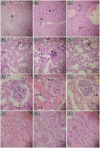Development of nano-emulsions based on Ayapana triplinervis essential oil for the control of Aedes aegypti larvae
- PMID: 34242328
- PMCID: PMC8270136
- DOI: 10.1371/journal.pone.0254225
Development of nano-emulsions based on Ayapana triplinervis essential oil for the control of Aedes aegypti larvae
Abstract
Ayapana triplinervis is a plant species used in traditional medicine and in mystical-religious rituals by traditional communities in the Amazon. The aim of this study are to develop a nano-emulsion containing essential oil from A. triplinervis morphotypes, to evaluate larvicidal activity against Aedes aegypti and acute oral toxicity in Swiss albino mice (Mus musculus). The essential oils were extracted by steam dragging, identified by gas chromatography coupled to mass spectrometry, and nano-emulsions were prepared using the low energy method. Phytochemical analyses indicated the major compounds, expressed as area percentage, β-Caryophyllene (45.93%) and Thymohydroquinone Dimethyl Ether (32.93%) in morphotype A; and Thymohydroquinone Dimethyl Ether (84.53%) was found in morphotype B. Morphotype A essential oil nano-emulsion showed a particle size of 101.400 ± 0.971 nm (polydispersity index = 0.124 ± 0.009 and zeta potential = -19.300 ± 0.787 mV). Morphotype B essential oil nano-emulsion had a particle size of 104.567 ± 0.416 nm (polydispersity index = 0.168 ± 0.016 and zeta potential = -27.700 ± 1.307 mV). Histomorphological analyses showed the presence of inflammatory cells in the liver of animals treated with morphotype A essential oil nano-emulsion (MAEON) and morphotype B essential oil nano-emulsion (MBEON). Congestion and the presence of transudate with leukocyte infiltration in the lung of animals treated with MAEON were observed. The nano-emulsions containing essential oils of A. triplinervis morphotypes showed an effective nanobiotechnological product in the chemical control of A. aegypti larvae with minimal toxicological action for non-target mammals.
Conflict of interest statement
The authors have declared that no competing interests exist.
Figures





References
-
- Akiner MM, Demirci B, Babuadze G, Robert V, Schaffner F. Spread of the invasive mosquitoes Aedes aegypti and Aedes albopictus in the Black Sea region increases risk of chikungunya, dengue, and Zika outbreaks in Europe. PLoS Negl Trop Dis. 2016; 10 (4): 1–5. doi: 10.1371/journal.pntd.0004664 - DOI - PMC - PubMed
-
- Leyva M, French L, Pino O, Montada D, Morejón G, Marquetti MDC. Plantas con actividad insecticida: una alternativa natural contra mosquitos. Estado actual de la temática en la región de las Americas. Rev Biomd. 2017; 28: 137–178. doi: 10.32776/revbiomed.v28i3.571 - DOI
-
- Teich V, Arinelli R, Fahham L. Aedes aegypti e sociedade: o impacto econômico das arboviroses no Brasil. J Bras Econ Saúde. (2017); 9 (1): 267–276.
MeSH terms
Substances
LinkOut - more resources
Full Text Sources
Other Literature Sources

